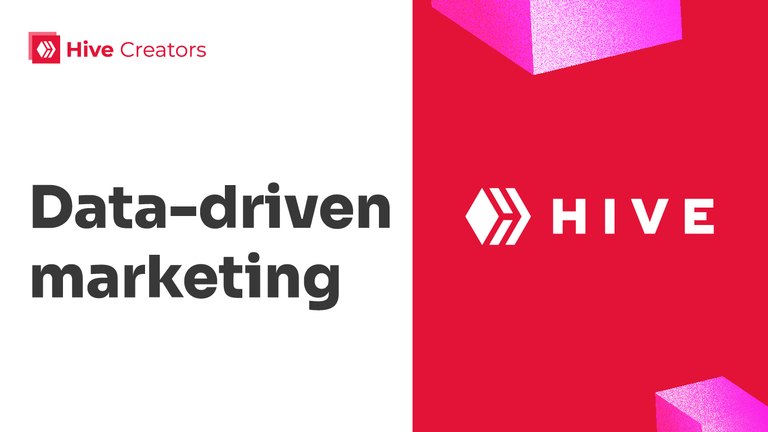
Hello, Hivers!
Have you ever wondered what's behind a marketing strategy that truly adds value? It starts with a clear vision of the desired results and, from there, charting a direct path toward those objectives.
Often, we think the key lies in a creative idea or flawless execution. While both are important, the real differentiator is the effective use of metrics that allow us to measure impact and adjust our strategy as we experiment.
It's easy to rely solely on intuition or ideas with a solid foundation, leading to erroneous assumptions. However, metrics play a fundamental role in identifying our capabilities and the need for adjustments to achieve the desired success.
Historically, metrics were a compliment; today, they are essential in modern marketing. That's why companies invest significant resources in developing tools that facilitate data tracking and allow for strategic adjustments on the fly.
The Importance of Metrics in Modern Marketing
On Hive, it's common for projects to be born from great ideas or initiatives. However, we risk moving into speculative territory without a clear focus on metrics. So, how do we ensure that our marketing campaigns are based on real data, not assumptions?
The key is to define clear metrics from the outset. Before undertaking any action—whether organizing an event, launching a digital campaign, or presenting a proposal to the DHF—we must ask ourselves these fundamental questions:
- What do I want to achieve with this campaign or initiative?
- How will I measure success?
- What specific value will this activity bring to Hive?
By answering honestly, we connect our strategies directly with the results we seek and can adjust them according to the data we collect.
The Challenge of Finding the Right or Viable Metrics
But beware, it's not just about measuring for the sake of measuring. One of the biggest challenges of data-driven marketing is identifying the "right" metric that truly reflects the success of our campaign. This is where a deep understanding of the relationship between our strategy and specific metrics comes into play.
For example, if you're organizing an event for Hive, it's crucial to ask yourself:
- What tangible value will this activity bring to Hive?
- Will it increase brand recognition within the crypto and Web3 community?
- Will it attract new users or communities to the blockchain?
- Will it create new digital spaces to interact with the Hive ecosystem?
Having clear answers to these questions allows you to establish metrics like the number of new users registered, engagement on social media, or even the number of collaboration proposals received after the event.
Remember, the "right" metric depends on the objective, and it is essential to choose the most relevant ones to measure success based on what you truly want to achieve.
Community Engagement: Key Metrics in the Blockchain Ecosystem
According to what we've learned in blockchain marketing, engagement goes far beyond a simple user registration. On Hive, the key metrics to measure user interaction should be based on their active participation within the ecosystem. Here are some metrics you can consider:
Active Users on the Blockchain: Number of registered users interacting directly with Hive through transfers, comments, or content publishing. These actions demonstrate that people are eager to try the technology.
Accounts with HIVE Staked: How many accounts have invested or acquired at least 50 HIVE in stake after registering? This indicator shows that users interact and are betting on the ecosystem long-term.
New Applications or Services: The number of new applications or services launched on Hive clearly indicates growth and attractiveness for developers and users.
Developer Contribution: Discovering how many new developers are involved in the open-source code of Hive applications or are experimenting with new protocols emerging in the ecosystem.
Growth of Users and Communities: Measuring Expansion
In addition to individual engagement, measuring the growth of users and communities within Hive, especially after events or marketing campaigns, is vital. Some questions that can help you in this measurement are:
Community Growth: How many new communities have been created or have joined Hive after participating in an event or campaign? This reflects our ability to attract and retain groups with common interests.
Influence from Web2 in the Web3 Ecosystem: How many influential users in the Web3 sector within Web2 have begun to mention or collaborate with Hive? This type of impact is key to expanding Hive's visibility beyond the crypto ecosystem and attracting new creators and investors.
Focusing on these metrics aligns us with the fundamental marketing principles. It's necessary to understand that marketing is not just about superficial interaction but about meaningful behaviors that drive growth and strengthen the Hive ecosystem.
Let's keep building together a solid and prosperous future for Hive!
Congratulations @hivecreators! You have completed the following achievement on the Hive blockchain And have been rewarded with New badge(s)
Your next target is to reach 50 posts.
You can view your badges on your board and compare yourself to others in the Ranking
If you no longer want to receive notifications, reply to this comment with the word
STOPCheck out our last posts: